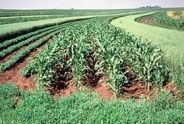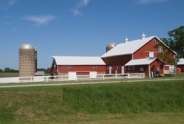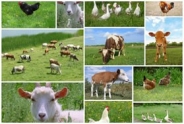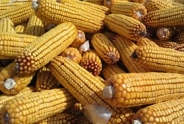Managing Weeds in Grass Pastures
Katelyn Miller, Field Crops and Forage Specialist
Southwest New York Dairy, Livestock and Field Crops Program
Recently, I have received quite a few calls asking, "How do I kill (*insert weed name*) in my pasture?". This time of year, many plants are flowering, making weed control a pressing topic. There are different management strategies involved in controlling weeds, including chemical, physical and cultural practices. Physical and cultural practices can include:
Managing fertility and pH:
Soil testing your pastures will allow you to effectively manage nutrition and pH in your pastures. Ensuring adequate nutrition and appropriate pH will allow your desired species to thrive and allow them to compete with weeds.
Mowing:
Traditionally, mowing is completed after livestock have grazed the pasture. Mowing is often completed to encourage new plant growth but can be an effective strategy to reduce weed seed production. This works well for species where the flower stem elongates like Wild Carrot. It's important to note that some weed species will adapt to frequent mowing and rosettes will grow closer to the ground like Horsenettle.
Proper rotation and grazing height:
It's important to give adequate rest periods for your pastures. Pastures should not be grazed below 3 inches as the energy is stored above ground in the crowns of the plants. Overgrazing can result in bare spots and weakened plants, giving more opportunity for weeds to thrive.
In addition to the management options mentioned above, chemical control options are available for grass pastures. An important component of using herbicides is properly identifying and understanding the biology of the weed you are trying to control. There are three main weed types: annual, biennial, and perennials. Annual weeds complete their life cycle within one year, meaning they grow, flower, produce seeds, and die within that time frame. Summer annual weeds conduct this life cycle throughout the summer growing season. Winter annuals begin their life cycle in the fall and complete it by early summer. Biennial weeds complete their life cycle over 2 years. The first year is comprised of vegetative growth, while the second year they flower and reproduce. Perennial weeds live longer than 2 years and complete their entire life cycle in one year. Each fall, they move all food reserves into their root system to survive until the following season.
Knowing the weed and its biology will help make the correct decision on what products to use, the rate, and the correct timing for control. Utilize Table 4.14.1 from the 2024 Cornell Guide for Integrated Field Crop Management for weed control options available in pastures. It covers different situations, the amount of product to apply per acre, application timing, and any additional limitations of the product. It's important to note that there are grazing and haying restrictions for many of the products listed.

Based on the time of year this article is being written, which is mid-summer, creeping perennial broadleaf weeds could be controlled with an herbicide. This would include weeds like Horsenettle and Common Milkweed. Fall will also be here before we know it, so if you commonly deal with weeds like Tall Buttercup or Curly Dock, the time for best control is coming soon.

This chart is designed to visualize the best time to make a spray application based on the above situations. While this chart may not be a perfect representation of spray timing, it shows that timing varies based on the biology of the weed.
The most effective way to manage weeds is utilizing an integrated approach. Relying on one management strategy is not recommended. All the herbicides listed here are within the same mode of action group. Repeatedly utilizing the same herbicide group on a plant can cause herbicide resistance to develop. All herbicides mentioned are designed to control broadleaf plants, meaning they will kill undesirable plants like Horsenettle, but will also kill any clovers, alfalfa or birdsfoot trefoil in the pasture. Grass weeds cannot be controlled in pastures with chemicals.
Every effort has been made to provide correct, complete and up-to‐date pesticide recommendations. Changes occur constantly and human errors are still possible. These recommendations are not a substitute for pesticide labeling. Please read the label before applying pesticides.
If you are interested in more information about weed management, contact Katelyn Miller by calling 716-640-2047 or by emailing km753@cornell.edu
Upcoming Events
Crops, Cows & Critters - Southwest New York Dairy, Livestock & Field Crops Newsletter Sponsorship
December 19, 2025
January 30, 2026
Our two forms of publications feature research-based and timely information from our four specialists, listed to the right, along with local event notifications and Cornell University outreach. This information is provided to participants who range from dairy, livestock, and field crops producers to agricultural suppliers and consultants.
Weekly Email Update: Shared with 625+ households who have signed up with our program.
Monthly Paper Mailer: To reach our stakeholders and farmers who lack internet access, we send out a monthly mailer where your company's logo and contact information would be featured with a mailing list of 330+ households.
If you sponsor our weekly and monthly publications you reach approximately 955 households.
Visit our website to view our newsletters!
2025 Cornell Food Beverage & Animal Feed Manufacturer Survey
December 19, 2025
Industry and Educational Advocates for New York State's Food, Beverage, and Animal Feed Manufacturing industries:
As you know, NYS has a diverse food and beverage manufacturing industry, in both the types of industries that exist and the wide distribution of firms by scale. Many manufacturing firms have strong backward linkages to agricultural production sectors in the state that support both farm-level and downstream food industry firms and consumers. In collaboration with the New York State Department of Agriculture and Markets, a team from Cornell University's Charles H. Dyson School of Applied Economics and Management has recently rolled out the 2025 New York State Food, Beverage, and Animal Feed Manufacturer Survey. The industry will benefit from an updated assessment of the industry that informs private and public investments and opportunities to support firm growth and improved profitability.
Boots in the Barn: Cornell Dairy Research Updates
January 13, 2026
January 20, 2026
January 27, 2026
February 3, 2026
February 10, 2026
February 17, 2026
February 24, 2026
Join us for some or all!
Announcements
No announcements at this time.





